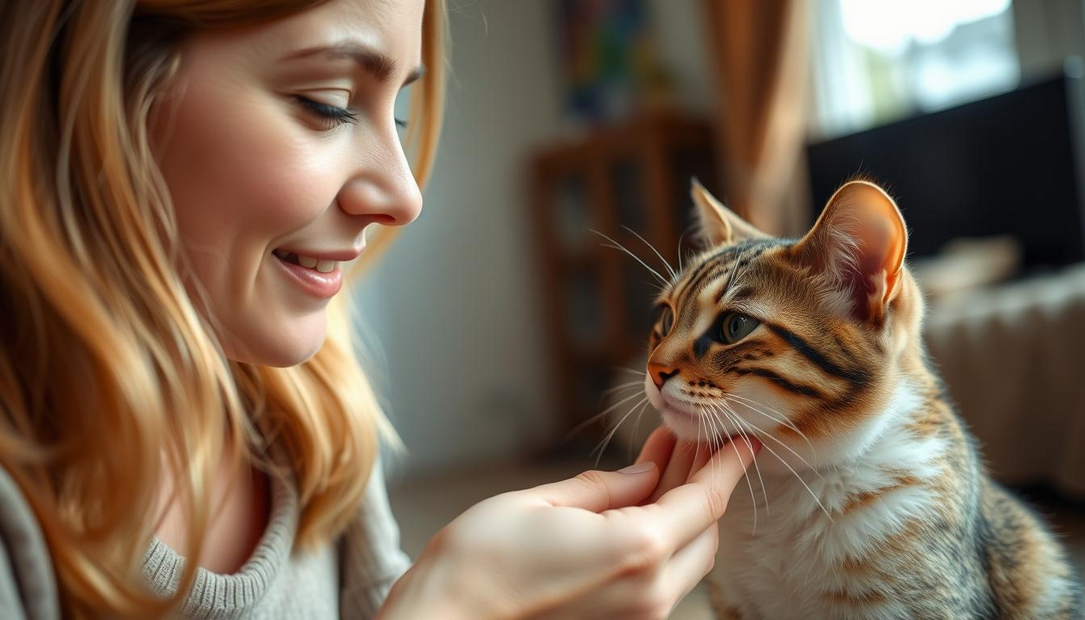India customers to view on amazon.in
How to Introduce a New Pet to Your Home Smoothly?
Bringing a new pet home is thrilling, but it needs careful planning. The introduction process makes your pet feel safe and lowers stress for all. It involves preparation, patience, and understanding their needs. This guide will help you make your home welcoming from the start.
- Preparing Your Home Before the New Pet Arrives
- Understanding Your New Pet’s Background
- The First Day: How to Introduce a New Pet to Your Home Smoothly
- Transportation Tips for Minimizing Stress
- Initial Home Introduction Techniques
- Giving Your Pet Space to Explore
- Introducing Your New Dog to Your Home Environment
- Bringing a New Cat Home: Special Considerations
- Introducing Your New Pet to Existing Pets
- Establishing Feeding, Sleeping, and Exercise Routines
- Common Adjustment Challenges and Solutions
- Dealing with Anxiety and Stress Behaviors
- Addressing Territorial Issues
- Managing Unexpected Health Concerns
- When to Seek Professional Help with Pet Integration
- Resources for New Pet Parents
- Conclusion: Creating a Forever Home for Your New Pet
- FAQ
- What are some essential supplies I need before bringing a new pet home?
- How can I create a safe sanctuary space for my new pet?
- What is the best way to introduce a new dog to my existing pets?
- How do I manage my new pet’s anxiety during the adjustment period?
- What are the signs that my new pet is struggling to adjust?
- How long will it take for my new pet to feel comfortable at home?
- Can I use calming products to help my new pet adjust?
- What are some breed-specific considerations for introducing a new dog?
- What should I do if my new cat is hiding all the time?
- How can I set up a feeding routine for my new pet?
Introducing a new pet, whether a puppy, kitten, or adult, begins before they arrive. A smooth transition requires preparing your home, getting supplies, and knowing your pet’s background. By following these steps, you’ll help them adjust and build a strong bond.

Key Takeaways
- Start with pet-proofing your home and gathering essential supplies like food, bowls, and bedding.
- Create a safe space for your new pet to explore at their own pace.
- Learn about your pet’s history to address any past experiences affecting their behavior.
- Use gradual introductions when meeting existing pets or family members.
- Monitor your pet’s body language for signs of stress and adjust your approach as needed.
Preparing Your Home Before the New Pet Arrives
Getting ready for a new pet is all about planning for their comfort and safety. Start with a new pet home setup that focuses on their well-being. Here’s how to get ready:
Essential Supplies to Purchase
Every pet needs the basics like food bowls, bedding, and toys. First-time pet owners should look into breed-specific items. For instance, cats need litter boxes, and dogs require collars with ID tags. Don’t forget vet records and grooming tools. A checklist helps avoid last-minute rushes:
- Food and water dishes
- Bed or crate
- Species-appropriate toys
- Cleaning supplies
Pet-Proofing Your Living Space
Hidden dangers can be found in open cabinets or dangling wires. Secure toxic plants, small objects, and cleaning chemicals. Block access to risky areas like staircases or balconies. Online resources offer pet transition tips for room-by-room safety checks.
Creating a Safe Sanctuary Space
A sanctuary space reduces stress during the first days home, says Dr. Mia Carter, a certified animal behaviorist. “A calm zone helps pets build trust.”
Design a quiet area with familiar scents and cozy bedding. For dogs, a crate with soft blankets works well. Cats might prefer a closed room with a litter box nearby. This space becomes their refuge while exploring the rest of the home.
Understanding Your New Pet’s Background
Every pet has a special history that shapes how they act. Before they come home, learn about their past. This includes where they lived before and any health issues. This info helps you meet their needs and avoid stress.
- Ask shelters or breeders about socialization experiences and past living conditions.
- Note any known allergies, fears, or health concerns affecting their pet adjustment tips.
- Understand breed-specific traits. For example, herding dogs may need extra exercise, while timid cats might need gradual how to help your pet adjust to a new home routines.
“A pet’s past isn’t just history—it’s a roadmap to their future happiness.” — Dr. Emily Carter, Animal Behavior Specialist
Watch how they act. A tucked tail or flattened ears might mean they’re anxious. Use this to make their new home a little easier. For example, a shy puppy might do well with a quiet spot or slow introductions.

Early life experiences really shape a pet’s behavior. Puppies that were socialized well adjust faster. For pets from shelters, be patient. Try to match their routine if you know it. Small, slow changes help build trust.
The First Day: How to Introduce a New Pet to Your Home Smoothly
Bringing a new pet home needs careful planning. These steps help build trust. Start by making the transport stress-free. A calm arrival helps pets adjust better. Follow these tips for a smooth transition.

Transportation Tips for Minimizing Stress
- Choose a carrier with secure latches and ventilation.
- Place a familiar blanket inside to reduce anxiety.
- Pause the drive if your pet trembles or hides. Offer treats to distract and reassure.
Initial Home Introduction Techniques
Let your pet sniff the carrier before opening. Place food and water in a quiet room. For multi-pet homes, swap bedding 24 hours prior. This helps pets recognize scents before seeing each other. Smooth pet introduction requires patience—avoid forcing direct contact for the first few hours.
Giving Your Pet Space to Explore
Unleash your pet only when they seem relaxed. Use treats to encourage exploring one room at a time. Watch for body language: flattened ears in dogs or dilated pupils in cats signal stress. Let them retreat to their safe space anytime.
“Let curiosity guide them—not your schedule,” says the American Veterinary Medical Association.
Introducing Your New Dog to Your Home Environment
Successfully introducing a new dog to your home starts with understanding your pet’s unique needs. Follow these steps to create a welcoming environment that fosters comfort and trust.

Breed-Specific Considerations
Every breed has distinct traits. For example, border collies thrive with active play, while terriers benefit from structured routines. Research your dog’s background to tailor your approach. New dog home tips include:
- High-energy breeds: Schedule daily exercise to avoid restlessness
- Sensitive breeds: Use calm tones and slow introductions to new spaces
- Working breeds: Provide puzzle toys for mental stimulation
Establishing Walking Routines
Walking routines are key to bringing a new pet home smoothly. Start with short, familiar routes to build confidence. Follow these steps:
- Begin walks near your home to mark territory
- Gradually increase distance and exposure to noises
- Use a secure leash and positive reinforcement
Training Basics for the First Week
Focus on foundational commands to help your dog settle in. Teach “sit,” “stay,” and “come” using treats and praise. Consistency builds trust:
- Designate a crate or bed as their safe zone
- Use consistent phrases for meals and walks
- Address accidents calmly with cleanup and retraining
Patience is vital. Celebrate small successes to strengthen your bond. A well-planned start ensures your new companion feels at home quickly.
Bringing a New Cat Home: Special Considerations
Introducing a new cat to your home needs patience and a special plan. First, set up a quiet room with a litter box, food, and water. This room lets your cat adjust slowly without feeling too stressed.
New cat home tips also suggest adding hiding spots. Use cardboard boxes or covered beds to make them feel safe.
Use familiar scents to help them feel at ease. Place a blanket from their old home in the sanctuary. This helps them recognize their new place.
Slowly introduce your scent by touching items in their space. This helps them get used to you.
- Allow 3–7 days in the sanctuary before opening the door.
- Swap rooms daily for scent familiarity.
- Use positive reinforcement with treats near shared spaces.
Making your pet feel at home means going at their pace. Don’t push them to interact too soon. Give them vertical spaces like cat trees to explore.
Keep feeding routines and play sessions gentle. If your cat hides, play calm music or a radio to mask sounds. Remember, cats may take weeks to settle in. Be patient for their long-term comfort.
Introducing Your New Pet to Existing Pets
Bringing a new pet home means using the right steps to keep peace. Start by picking a neutral place like a backyard or a friend’s house. This helps dogs and cats focus on their new surroundings, not their old home.

- Step 1: Use baby gates or crates during first meetings. This creates safe visual contact without physical clashes.
- Step 2: Watch for calm body language. Play bows or relaxed tails mean things are going well.
- Step 3: Separate pets if they show signs like hissing or stiff postures. Wait until they calm down before trying again.
When introducing a new dog to an existing pet, start with short walks. Use treats to reward calm behavior. Most dogs need 2–4 weeks of gradual exposure before they feel comfortable together.
A slow approach is key. Introducing pets seamlessly takes patience, not speed. Rushing can undo weeks of progress.
- Days 1–7: Scent swapping and separate feeding areas.
- Weeks 2–4: Short supervised play sessions (5–10 minutes daily).
- Months 1–3: Full integration only after consistent positive interactions.
Every animal’s timeline is different. Celebrate small wins and always put safety first.
Establishing Feeding, Sleeping, and Exercise Routines
Having a daily routine is key for pets to adjust well. It helps reduce stress and builds trust. Start by keeping the same feeding times and diet as before. Then, slowly change them over a few weeks.

Feeding: Use a new pet guide to plan meals. Dogs do best with two meals a day, while cats might like to eat whenever they want. Put their bowls in quiet spots to avoid fights. Slowly introduce new food over 7–10 days, starting with 25% new and 75% old.
- Stick to set times to avoid overeating or anxiety.
- Use slow-feeder bowls for pets prone to gulping.
Sleep: Pick cozy beds that fit your pet’s size and breed. Dogs like crates for safety, while cats prefer high places. Place their beds near you but not where drafts can get in. Add blankets or pheromone diffusers to help them relax.
Exercise: Dogs need 30–60 minutes of walks every day. Cats enjoy playing with toys like feather wands. Start with short play times and gradually make them longer. Toys that challenge their minds, like puzzle toys, keep them from getting bored.
“Routine creates a predictable world for pets, reducing anxiety.” – American Veterinary Medical Association
Adjust these routines to fit your work schedule. Use puzzle feeders or hire pet sitters if needed. Keeping these routines consistent helps pets feel secure and adjust faster.
Common Adjustment Challenges and Solutions
Bringing a pet home is exciting, but challenges may arise. This section offers pet adjustment help to address stress, territorial disputes, and health changes during the transition.

Dealing with Anxiety and Stress Behaviors
Excessive barking, pacing, or hiding signal anxiety. Use these strategies for a smoother transition:
- Provide a quiet room with familiar bedding and toys to create a safe zone.
- Try pheromone diffusers or calming music to reduce stress.
- Stick to consistent feeding and walk schedules to build routine.
Addressing Territorial Issues
Marking, growling, or food guarding often surface when pets feel threatened. Follow this new pet transition guide:
- Supervise interactions between pets and reward calm behavior with treats.
- Feed existing and new pets separately to reduce competition.
- Gradually introduce shared spaces using scent swapping and supervised play.
Managing Unexpected Health Concerns
Changes like diarrhea or loss of appetite may occur. Distinguish adjustment stress from illness:
Signs needing vet care: vomiting, lethargy lasting >48 hours, or refusal to eat.
Adjustment-related behaviors: temporary pacing or hiding often improve with time and patience.
Consistency and compassion are key to helping pets feel secure during transitions.
When to Seek Professional Help with Pet Integration
Even with the best way to introduce a new pet to your household, some pets may struggle. It’s important to know when to get expert help. This ensures your pet’s happiness during this big change.

Signs Your Pet Is Struggling to Adjust
Look for these signs for more than two weeks:
- Refusal to eat or drink for over 24 hours
- Aggression toward people or other pets
- Self-harm behaviors like excessive grooming or scratching
- Constant hiding or avoidance of social interaction
Finding the Right Behavioral Specialist
Look for these experts:
- Certified Applied Animal Behaviorists (CAAB) with species-specific training
- Board-Certified Veterinary Behaviorists for medical-behavioral overlaps
- Trainers certified in positive reinforcement methods
First, get a full vet check to rule out health problems. Ask for references and check their credentials with groups like the International Association of Animal Behavior Consultants.
Getting help early can make a big difference. Remember, asking for help is part of being a good pet parent. It shows you care about your pet’s happiness and well-being.
Resources for New Pet Parents
Every new pet parent needs support! Start with trusted first-time pet owner guide: bringing a pet home resources. Look at pet introduction tips from ASPCA’s online guides or the pet settling guide in “The Complete New Pet Owner Handbook.”
- Books: “Positive Puppy Training” by Punyencore or “Cat Behavior Basics” for first-time pet owner tips.
- Apps: Try Petcube for activity tracking or PetDesk for vet reminders.
- Local: Join Meetup groups for adopter support or visit Petco’s community boards.

“Education builds confidence—never hesitate to ask questions!” – Dr. Jane Smith, Fear-Free Certified Veterinarian
Connect with certified trainers through the Certification Council for Professional Dog Trainers (CCPDT).org). For multi-pet households, review the Humane Society’s pet introduction tips for gradual integration steps. Local shelters often host free workshops on crate training or nutrition planning. Always choose a vet using the American Animal Hospital Association’s directory for first-time pet owner guide compatibility.
Conclusion: Creating a Forever Home for Your New Pet
Bringing a new pet home is exciting, but it’s just the start. Each pet adjusts at their own speed. Whether it’s a dog, cat, or other pet, patience is crucial.
Strategies like creating safe spaces and managing interactions are key. Small signs of progress, like sniffing a new room or playing with a toy, show you’re on the right track.
Routines are important during the adjustment phase. Consistent feeding, exercise, and quiet time help your pet feel safe. Paying attention to their cues and responding calmly builds trust.
For extra help, check out the ASPCA’s behavior tips or local workshops. Keeping a photo journal helps you see how far your pet has come.
Helping your pet settle in means finding a balance between routine and flexibility. Celebrate quiet moments, like when they nap near you or explore without fear. These moments build trust over time.
While the first weeks may be unpredictable, enjoy the journey. Every barked greeting or purr is a step towards a life filled with understanding.
Your role as a caregiver grows as your pet becomes more confident. Stay patient and watchful to create a nurturing environment. The journey may be unique, but the reward of a forever bond is worth it. Welcome your pet’s personality and let them set the pace.
FAQ
What are some essential supplies I need before bringing a new pet home?
Before bringing a new pet home, you’ll need some key supplies. This includes a comfy bed, dishes for food and water, and toys. You’ll also need grooming tools and health items like a collar and leash for dogs, or a litter box for cats.
How can I create a safe sanctuary space for my new pet?
Creating a safe space is key for your pet’s comfort. Dogs might like a crate in a quiet spot. Cats prefer a room with hiding spots and familiar smells. This space helps them feel safe when they’re feeling overwhelmed.
What is the best way to introduce a new dog to my existing pets?
Introduce dogs in a neutral area first. Let them meet outside their home. Watch for signs of happiness like wagging tails. Give them time to get used to each other.
How do I manage my new pet’s anxiety during the adjustment period?
To manage anxiety, keep routines the same. Provide a safe space and toys to distract them. Positive reinforcement helps too.
What are the signs that my new pet is struggling to adjust?
Signs of struggle include hiding a lot, not eating, and destructive behavior. If these signs last, see a vet or animal behaviorist.
How long will it take for my new pet to feel comfortable at home?
Adjustment time varies, from days to months. Be patient and let them adjust at their own pace.
Can I use calming products to help my new pet adjust?
Yes, calming products like pheromone diffusers and herbal supplements can help. Always check with your vet first.
What are some breed-specific considerations for introducing a new dog?
Different breeds have unique needs. High-energy dogs need lots of exercise, while sensitive breeds need quiet and gentle handling. Knowing these traits helps tailor your approach.
What should I do if my new cat is hiding all the time?
Cats often hide in new places. Make sure they have a safe spot and give them time to explore. Play and treats can help build their confidence.
How can I set up a feeding routine for my new pet?
Start with their old diet for a few days before switching. Feed them at the same times every day. This helps them feel secure and comfortable.







